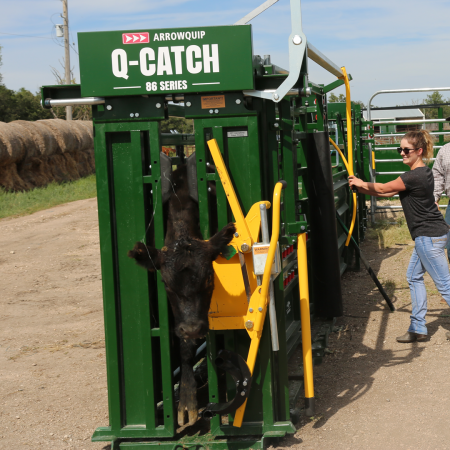10 Reasons Why You Need a Proper Cattle Crush

Cattle crushes are an essential part of any operation. A cattle crush improves management, because catching and restraining cattle becomes easy compared to a yoke gate at the end of an race. Livestock and handler safety are increased and animal stress decreases when using a cattle crush.
A 2011 Canadian Cattlemen article by Roy Lewis, DVM recommends that producers ask their veterinarian's opinion on a cattle crush. Lighter crushes are not made for herds with several hundred head or more, notes Dr. Lewis. Most operations require higher quality materials and more crush options. Cattle crushes also have fewer cattle break out prior to completion of the procedure.
We have 10 reasons why you need a proper cattle crush on your farm.
1. Cattle crushes are safe, humane, and efficient. We all need to utilize the facilities that are in the best interest of our animals as part of the producer code of cattle care.
2. Cattle don't feel pressured by a good cattle crush. Pressure points are removed and a clear line of sight is ensured. When cattle are under less pressure and walk through the crush instead of running, it limits injury to livestock and the farmer, both issues that are often seen in low-cost cattle crates.
3. Crushes keep cattle focused. The wide-angle vision field of cattle allows them to see 300 degrees. This can lead to balking or becoming frightened by unknowns. A well-designed crush reduces stress by ensuring cattle stay focused on the exit, allowing them to see light and think they are escaping rather than walking into a wall.
4. Noise is reduced or eliminated in a cattle crush. This keeps your cattle calm while you're working on them, and again, reduces stress.
5. Animal health is improved using proper cattle crush. Improper equipment and working cattle too quickly can lead to bruises, injection site damage, human injuries and incorrect records, according to faculty at Virginia Tech. Negative effects from stress cause lower conception rates, reduce vaccination effectiveness, and reduce immune and rumen functions.
6. Livestock handlers are safer from injury from cattle throwing their heads or kicking. Latches on commercial cattle crushes are also less likely to injure a handler if accidentally released.
7. Cattle crushes can be adjusted to the size of the cattle being handled.
8. Cattle crushes support the animal. This reduces balking prior to the crush, choking, or falls in the crush. It also prevents cattle from turning around.
9. Cattle can be quickly and safely released from a crush when handlers have finished procedures.
10. Cattle crushes increase the economic viability of your farm. Precise dosages of products minimizes waste, more efficient equipment saves time, fewer handlers are needed to perform procedures, and safety for cattle and handlers increases, reducing medical or veterinary bills.
Before you use your cattle crush, you should conduct a safety assessment, and walk through to make sure that nothing is broken, or will injure or distract cattle. Reducing stress in cattle handling situations can save time when cattle must be handled again in the future. Cattle with bad experiences in a yoke gate or race will be harder to catch the next time a procedure is needed.
Cattle crushes designed by Arrowquip are functional and economical. We continue to seek innovative design and engineering that adheres to the latest research from top animal science experts worldwide, including eliminating noise in our cattle crushes and taking the manual work out of the manual squeeze crush.
A proper cattle crush is quickly added to your list of essential equipment by increasing livestock and handler safety, and preventing injury or death.
Ready to upgrade your operation with a new cattle crush for enhanced efficiency and ease of use? Check out our extensive lineup of manual or hydraulic cattle crushes to find the perfect fit for your needs.
Sources:
Virginia Tech
Temple Grandin
Roy Lewis, DVM article in Canadian Cattlemen
BQA
Drovers
About the Author

Dana Charban
As a small town girl from rural Manitoba, Dana Charban grew up around agriculture and farming her en...More Information on Dana Charban
Email Dana Charban:




Comments
Join the Discussion
Comments